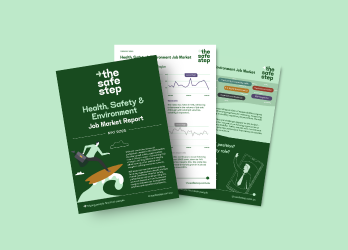Capability Development to Advance your Career and the HSE profession
Page Published Date:
March 28, 2022
Pandemic-related challenges have compelled health and safety professionals to pivot, ramp-up skills and evolve practices at speed. It’s been a steep (and exhausting) learning curve for many.
On-the-go learning has been essential over the last couple of years, but greater long-term value comes from growing your capabilities in a structured and sustained way. Watch the video below or read on to learn more.
The importance of ongoing learning
Plugging your gaps, extending capabilities and keeping current will help you become a more well-rounded HSE professional.
Evidence of certification including your ongoing capability development will assist you to stand out from the crowd when applying for a promotion, or when seeking a new job. “Employers seek health and safety professionals who bring a thirst for learning and development and an ability/desire to contribute beyond the role itself,” explains The Safe Step CEO Aaron Neilson. “It is important to ensure that you continue to learn, to build knowledge and experience in areas you do not have depth,” he says.
In 2022 demand has increased for expertise around psychosocial risk, environmental health, ESG and wellbeing as organisations look to adopt more informed practice and thinking in these areas. Other key areas for development include business acumen, influencing/communication skills and emerging technologies.
Developing capability
There are many ways to build capability within yourself and your workforce as a whole.
Individual development can come from online learning, mentoring programs or through professional associations and groups. Accessing and contributing to networks assists learning and may potentially connect you with your next employment opportunity. “It is critical for you to stay connected to the broader profession, to network and engage with peers, to understand the different thinking and approaches out there and to challenge your own thinking,” explains Neilson.
Measuring yourself against a global framework of practice is another good starting point. Understand where in the framework you sit and what skills, experience and capabilities you need to move to the next level of your career.
Formal accreditation programs such as the one offered by the Australian Institute of Health & Safety (AIHS) offer sustained development pathways informed and evaluated against international standards. The aim is to help the sector build credibility and maturity. “This is an adolescent profession,” says AIHS CEO David Clarke, “We're putting a structure in place where like the more mature professions, through ongoing CPD, people are able to engage in lifelong learning and this becomes a normal part of the profession’s culture,” he adds
Feedback from the profession including HSE leaders over the past 2-3 years has resulted in changes to the AIHS program to improve the accessibility and quality of the process, alongside relevance to industry needs. An increasing number of HSE leaders are seeing the benefits of lifting the skills of workers and the profile of the profession as a whole, by utilising Certification. David Clarke explained that the AIHS would continue to focus on improvements and especially recognising the diversity of ways people enter the profession, and move through it. “We didn’t get everything right initially, but recent changes have addressed many of these shortcomings. This is the first generation of a program which will continue to evolve to ensure it becomes an integral part of a culture of ongoing learning and continuous improvement in the capability of the whole profession.” Clarke says.
Certification case study - Laing O’Rourke
Employers with large health and safety teams may find it difficult to manage capability development on their own. “My team is incredibly diverse, both from an education perspective, an experience perspective and knowledge and specialisation perspective. So diverse actually, that it's that it's really quite hard to define the capabilities and the gaps,” explained Richard Coleman, General Manager of Safety at Laing O’Rourke at a recent Safe Step HSE leaders’ forum.
To enhance skills across the HSE function Laing O’Rourke chose to partner with the AIHS to develop a structured, yet tailored development program for its workforce. Phase 1 involved individual assessment for staff, followed by the implementation of a tailored plan for each employee. “Where we find holes in education, skills or experience, we'll plug them with a personalised development plan,” Coleman says. Participation is voluntary and as well as enhancing individual career prospects, will also allow Laing O’Rourke’s HSE function to up-skill at scale.
Making the business-case for investment in accreditation was relatively straight-forward for Coleman, who likened the initiative to processes undertaken by other professionals within the business such as accountants, engineers and lawyers. He also saw ongoing professional development as essential for fulfilling the brand promise to ‘deliver certainty through the power of experience’. “We're very big on trying to make sure that the various functional streams in our organisation are as strong as they can be,” says Coleman.
3 key benefits of HSE certification
As Richard Coleman sees it certification has a number of advantages for individuals and the profession as a whole:
- Positions you for long-term career success.
“The industry moves in boom and bust cycles,” explained Laing O’Rourke’s Head of Safety, Richard Coleman when speaking at a Safe Step leaders forum. “Take steps to ensure you can be more effective in your role, not just today but also in the future.” - Improves workforce engagement & effectiveness.
Fostering a culture of learning and development can help raise the skills, profile and engagement of HSE teams. “I want to lift our workforce to be more effective. I want them to be more impactful and I want them to be more engaged in the business,” says Coleman - Elevates the credibility of the profession.
Creating a unified and mature profession, with a high-caliber of workers attracts new people to the vocation and engenders greater trust amongst the public and business communities. “We get a better outcome if, as a profession, we lift everyone up to an agreed, rigorous standard” says Coleman.
How can we help?
As HSE recruitment specialists we know what it takes to stand out from the crowd in health and safety.
With a broad overview of industry demand and best practice, your Safe Step consultant can help you understand how your skills and experience match-up in the market. We’re keen to hear your career ambitions and how we can help you fulfil them.
Taking a long-term view of your career, we can offer advice on how to position yourself for a step-up role, or work-towards a longer-term ambition. If you are ready for your next role, we may even be able to connect you with a business that invests in professional development opportunities and will support life-long learning opportunities.




